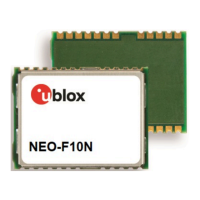NEO-F10N-Integration manual
Feature Change Action needed / Remarks
Digital IO
External IO isolation is required.
The output current of the digital IOs
is 2 mA compared to 4 mA in NEO-8Q
and NEO-M8 modules, except for the
TIMEPULSE pin, which still provides
drive strength of 4 mA.
Caution! Risk of receiver damage. If the IO pins are not isolated,
the GNSS receiver may get permanently damaged when high
current is drawn from the IO pins. Use external IO isolation to
avoid receiver damage.
Do not drive IOs when VCC is not supplied. Removing the VCC
supply does not isolate the module IO pins from the the host
device IO pins.
You may need to use additional external pull-up resistors to
increase the drive strength of the digital IO output pin or adjust
the load accordingly.
Table 13: NEO-F10N hardware features compared to NEO-8Q/M8 modules
A.2 Software changes
Table 14 presents a summary of the key software-related changes between u-blox F10 and u-blox
M8.
Feature Change Action needed / Remarks
Signals
Default GNSS
configuration
NEO-F10N: Dual-band L1/L5 signals for GPS, Galileo, BeiDou
B1C/B2a and SBAS.
NEO-M8N/Q/M/J: Single-band L1 signals GPS, GLONASS, QZSS
and SBAS.
Code change (optional)
HW change (optional):
requires antenna selection
or antenna frequency
tuning and any additional
filtering in the previous
NEO-M8 designs to
support L5 frequency
band.
GPS L5 New signal. Code change (optional)
BeiDou B1C New signal. BeiDou satellite IDs up to 63 supported. Code change (optional)
BeiDou B2a New signal. BeiDou satellite IDs up to 63 supported. Code change (optional)
Galileo E5a New signal. Code change (optional)
GLONASS GLONASS system is not supported. Code change
SBAS New SBAS PRN selection: 123, 126-129, 131, 133, 136-138. Code change (optional)
QZSS L1S SLAS corrections are now applied for navigation. Code change (optional)
QZSS IMES Not supported in current firmware. Code change (optional)
NavIC SPS L5 New signal. Code change (optional)
Protocols
NMEA
Supports NMEA V4.11, V4.10, V4.0, V2.3, and V2.1. NMEA V4.11
is enabled by default.
In u-blox F10, the NMEA GSV messages for zero signal C/No level
are grouped separately as compared to u-blox M8. If the signal's
C/No level is 0, the FW treats it as an unknown signal for not
being able to track it and sets the "signal ID" to zero. The FW
then creates separate GSV messages for grouping the untracked
signals with zero C/No and other messages for grouping the
tracked signals with non-zero C/No. In the untracked signals
message group, the C/No field is blank (i.e. , ,). There is no
configuration to revert this to the u-blox M8 format.
Code change (optional)
RTCM Not supported in current firmware. Code change
General
Configuration concept New configuration scheme using UBX-CFG-VALSET and UBX-
CFG-VALGET messages.
Code change
UBXDOC-963802114-12193 - R02
Appendix Page 35 of 42
C1-Public

